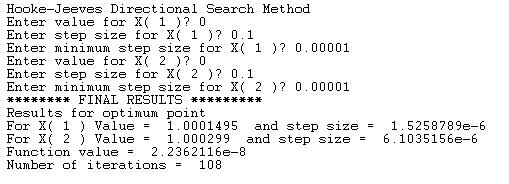
The following program calculates the minimum point of a multi-variable function using the Hooke-Jeeves directional search method.
The program prompts you to enter for each variable:
1. Guess for the minimum point.
2. Initial search step value.
3. The minimum search step value.
The program displays intermediate results to show the iteration progress and also the following final results:
1. The coordinates of the minimum value.
2. The step size for each variable.
3. The minimum function value.
4. The number of iterations
The current code finds the minimum for the following function:
f(x1,x2) = 100 *(x1 ^ 2 - x2) ^ 2 + (1 - x1) ^ 2
Here is a sample session (the intermediate results have been edited out to shorten the session screen and to focus on the input and final output):

Here is the BASIC listing:
! Directional Search using Hooke and Jeeves method
OPTION TYPO
OPTION NOLET
DECLARE NUMERIC MAX_VARS
DECLARE NUMERIC N, I, K
DECLARE NUMERIC Iter, MaxIter
DECLARE NUMERIC F, XX, Lambda, bOK
DECLARE NUMERIC BestF, LastBestF, EPSF
DECLARE NUMERIC bStop, bMadeAnyMove
DECLARE NUMERIC bTrue, bFalse
Dim X(1), Xnew(1)
Dim StepSize(1)
Dim MinStepSize(1)
Dim DeltaX(1)
Dim bMoved(1)
bTrue = 1
bFalse = 0
!---------------- Declare SUBs -------------------
SUB MyFx(X(), N, Res)
Res = 100 * (X(1) ^ 2 - X(2)) ^ 2 + (1 - X(1)) ^ 2
! Res = X(1) - X(2) + 2 * X(1) ^ 2 + 2 * X(1) * X(2) + X(2) ^ 2
End SUB
SUB MyFxEx(N, X(), DeltaX(), Lambda, Res)
LOCAL I
Dim X2(1)
MAT ReDim X2(N)
For I = 1 To N
X2(I) = X(I) + Lambda * DeltaX(I)
Next I
CALL MyFx(X2, N, Res)
End SUB
Sub GetGradients(X(), N, Deriv(), DerivNorm)
LOCAL XX, I, H, Fp, Fm
DerivNorm = 0
For I = 1 To N
XX = X(I)
H = 0.01
If Abs(XX) > 1 Then H = H * XX
X(I) = XX + H
CALL MyFx(X, N, Fp)
X(I) = XX - H
CALL MyFx(X, N, Fm)
X(I) = XX
Deriv(I) = (Fp - Fm) / 2 / H
DerivNorm = DerivNorm + Deriv(I) ^ 2
Next I
DerivNorm = Sqr(DerivNorm)
End Sub
SUB LinSearch_DirectSearch(X(), N, Lambda, DeltaX(), InitStep, MinStep, boolRes)
LOCAL F1, F2
CALL MyFxEx(N, X, DeltaX, Lambda, F1)
Do
CALL MyFxEx(N, X, DeltaX, Lambda + InitStep, F2)
If F2 < F1 Then
F1 = F2
Lambda = Lambda + InitStep
Else
CALL MyFxEx(N, X, DeltaX, Lambda - InitStep, F2)
If F2 < F1 Then
F1 = F2
Lambda = Lambda - InitStep
Else
! reduce search step size
InitStep = InitStep / 10
End If
End If
Loop Until InitStep < MinStep
boolRes = bTrue
End SUB
!---------------------------- MAIN PROGRAM --------------------
! Directional Search using Hooke and Jeeves method
MAX_VARS = 2
N = MAX_VARS
MAT REDIM X(MAX_VARS), Xnew(MAX_VARS)
MAT REDIM StepSize(MAX_VARS)
MAT REDIM MinStepSize(MAX_VARS)
MAT REDIM DeltaX(MAX_VARS)
MAT REDIM bMoved(MAX_VARS)
PRINT "Hooke-Jeeves Directional Search Method"
For I = 1 To N
PRINT "Enter value for X(";I;")";
INPUT Xnew(I)
PRINT "Enter step size for X(";I;")";
INPUT StepSize(I)
PRINT "Enter minimum step size for X(";I;")";
INPUT MinStepSize(I)
Next I
! calculate and display function value at initial point
CALL MyFx(Xnew, N, BestF)
LastBestF = 100 * BestF + 100
Iter = 0
Do
Iter = Iter + 1
For I = 1 To N
X(I) = Xnew(I)
Next I
For I = 1 To N
bMoved(I) = bFalse
Do
XX = Xnew(I)
Xnew(I) = XX + StepSize(I)
CALL MyFx(Xnew, N, F)
If F < BestF Then
BestF = F
bMoved(I) = bTrue
Else
Xnew(I) = XX - StepSize(I)
CALL MyFx(Xnew, N, F)
If F < BestF Then
BestF = F
bMoved(I) = bTrue
Else
Xnew(I) = XX
Exit Do
End If
End If
Loop
Next I
! moved in any direction?
bMadeAnyMove = bTrue
For I = 1 To N
If bMoved(I) = 0 Then
bMadeAnyMove = bFalse
Exit For
End If
Next I
If bMadeAnyMove = 1 Then
For I = 1 To N
DeltaX(I) = Xnew(I) - X(I)
Next I
Lambda = 1
CALL LinSearch_DirectSearch(X, N, Lambda, DeltaX, 0.1, 0.0001, bOK)
If bOK = bTrue Then
For I = 1 To N
Xnew(I) = X(I) + Lambda * DeltaX(I)
Next I
End If
End If
CALL MyFx(Xnew, N, BestF)
! reduce the step size for the dimensions that had no moves
For I = 1 To N
If bMoved(I) = bFalse Then StepSize(I) = StepSize(I) / 2
Next I
! show results
Print "For iteration ";Iter
For I = 1 To N
Print "For X(";I;") Value = ";X(I);" and step size = ";StepSize(I)
Next I
Print
! remove next set of comments to pause between results
! If Remainder(Iter, 8) = 0 And Iter > 0 Then
! Print "Press any key to continue ...";
! GET KEY K
! End If
LastBestF = BestF
bStop = bTrue
For I = 1 To N
If StepSize(I) >= MinStepSize(I) Then
bStop = bFalse
Exit For
End If
Next I
Loop Until bStop = bTrue
Print "******** FINAL RESULTS *********"
Print "Results for optimum point"
For I = 1 To N
Print "For X(";I;") Value = ";X(I);" and step size = ";StepSize(I)
Next I
Print "Function value = ";BestF
Print "Number of iterations = ";Iter
END
The above listing has a set of commented statements that
when uncommented will allow you to pause during the display of the intermediate
results. The current code will display these intermediate results without
pausing. For a large number of iterations, you will only see the data for the
trailing iterations.
Copyright (c) Namir Shammas. All rights reserved.